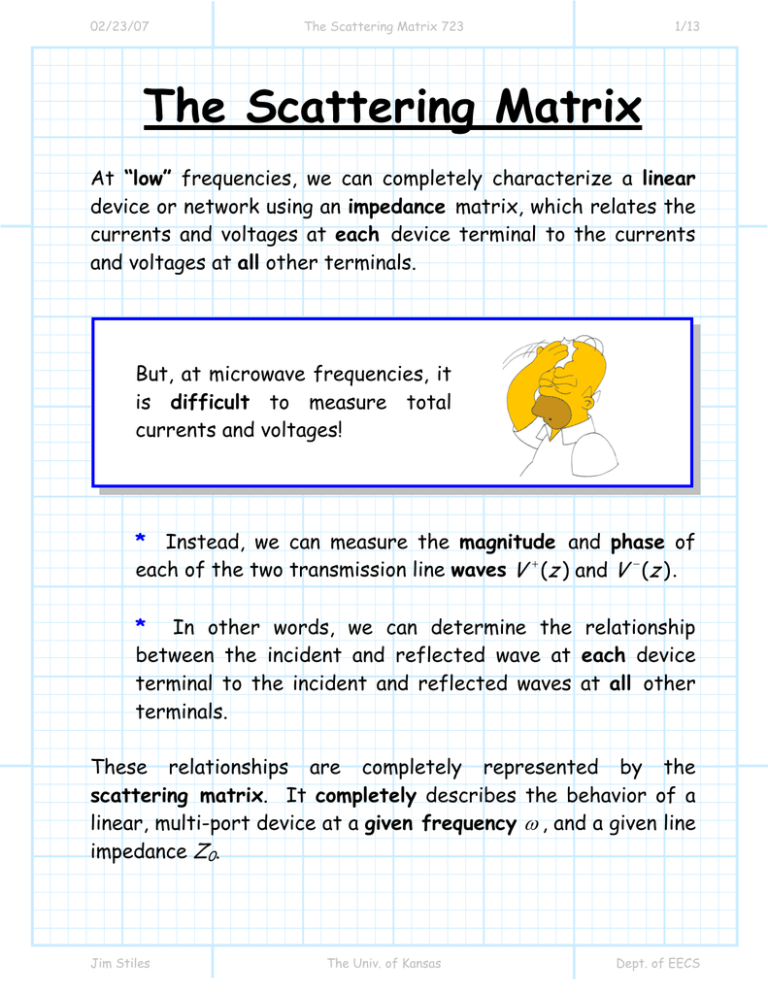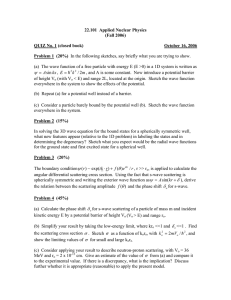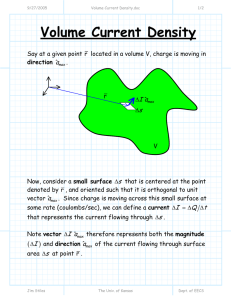The Scattering Matrix
advertisement

02/23/07 The Scattering Matrix 723 1/13 The Scattering Matrix At “low” frequencies, we can completely characterize a linear device or network using an impedance matrix, which relates the currents and voltages at each device terminal to the currents and voltages at all other terminals. But, at microwave frequencies, it is difficult to measure total currents and voltages! * Instead, we can measure the magnitude and phase of each of the two transmission line waves V + (z ) and V − (z ) . * In other words, we can determine the relationship between the incident and reflected wave at each device terminal to the incident and reflected waves at all other terminals. These relationships are completely represented by the scattering matrix. It completely describes the behavior of a linear, multi-port device at a given frequency ω , and a given line impedance Z0. Jim Stiles The Univ. of Kansas Dept. of EECS 02/23/07 The Scattering Matrix 723 2/13 Consider now the 4-port microwave device shown below: V2− ( z 2 ) Z0 port 2 V1 + ( z1 ) V2+ ( z 2 ) z 2 = z 2P port 1 port 3 4-port microwave device Z0 V1 − ( z1 ) z1 = z1P Z0 z3 = z3P port 4 V4+ ( z 4 ) V3− ( z 3 ) V3+ ( z 3 ) z 4 = z 4P Z0 V4− ( z 4 ) Note that we have now characterized transmission line activity in terms of incident and “reflected” waves. Note the negative going “reflected” waves can be viewed as the waves exiting the multi-port network or device. Æ Viewing transmission line activity this way, we can fully characterize a multi-port device by its scattering parameters! Jim Stiles The Univ. of Kansas Dept. of EECS 02/23/07 The Scattering Matrix 723 3/13 Say there exists an incident wave on port 1 (i.e., V1 + ( z1 ) ≠ 0 ), while the incident waves on all other ports are known to be zero (i.e., V2+ ( z 2 ) =V3+ ( z 3 ) = V4+ ( z 4 ) = 0 ). port 1 V1 + ( z1 ) + Z0 V1 + (z 1 = z1 p ) − Say we measure/determine the voltage of the wave flowing into port 1, at the port 1 plane (i.e., determine V1 + ( z1 = z1P ) ). z 1 = z 1P V2− ( z 2 ) port 2 Say we then measure/determine the voltage of the wave flowing out of port 2, at the port 2 plane (i.e., determine V2− ( z2 = z2P ) ). + V2 − (z 2 = z2p ) Z0 − z 2 = z 2P The complex ratio between V1 + (z1 = z1P ) and V2 − (z 2 = z 2P ) is know as the scattering parameter S21: V2− (z 2 = z 2P ) V02− e + j β z P V02− + j β (z P +z P ) = = S21 = + e V1 (z1 = z1P ) V01+ e − j β z P V01+ 2 2 1 1 Likewise, the scattering parameters S31 and S41 are: V3− (z 3 = z 3P ) S31 = + V1 (z1 = z1P ) Jim Stiles and The Univ. of Kansas V4− (z 4 = z 4P ) S41 = + V1 (z1 = z1P ) Dept. of EECS 02/23/07 The Scattering Matrix 723 4/13 We of course could also define, say, scattering parameter S34 as the ratio between the complex values V4+ (z 4 = z 4P ) (the wave into port 4) and V3 − (z 3 = z 3P ) (the wave out of port 3), given that the input to all other ports (1,2, and 3) are zero. Thus, more generally, the ratio of the wave incident on port n to the wave emerging from port m is: Smn Vm− (z m = z mP ) = + Vn (zn = znP ) (given that Vk + ( z k ) = 0 for all k ≠ n ) Note that frequently the port positions are assigned a zero value (e.g., z1P = 0, z 2P = 0 ). This of course simplifies the scattering parameter calculation: Smn Vm− (z m = 0) V0−m e + j β 0 V0−m = + = = Vn (zn = 0) V0n+ e − j β 0 V0n+ Microwave lobe We will generally assume that the port locations are defined as znP = 0 , and thus use the above notation. But remember where this expression came from! Jim Stiles The Univ. of Kansas Dept. of EECS 02/23/07 The Scattering Matrix 723 5/13 Q: But how do we ensure that only one incident wave is non-zero ? A: Terminate all other ports with a matched load! Γ2 L = 0 V2− ( z 2 ) Z0 V2+ ( z 2 ) = 0 V3− ( z 3 ) V1 + ( z1 ) 4-port microwave device Z0 Z0 V1 − ( z1 ) Γ 3L = 0 V3+ ( z 3 ) = 0 V3+ ( z 3 ) = 0 Z0 V4− ( z 4 ) Γ 4L = 0 Jim Stiles The Univ. of Kansas Dept. of EECS 02/23/07 The Scattering Matrix 723 6/13 Note that if the ports are terminated in a matched load (i.e., Z L = Z 0 ), then ΓnL = 0 and therefore: Vn+ ( zn ) = 0 In other words, terminating a port ensures that there will be no signal incident on that port! Q: Just between you and me, I think you’ve messed this up! In all previous handouts you said that if ΓL = 0 , the wave in the minus direction would be zero: V − (z ) = 0 if ΓL = 0 but just now you said that the wave in the positive direction would be zero: V + ( z ) = 0 if ΓL = 0 Of course, there is no way that both statements can be correct! A: Actually, both statements are correct! You must be careful to understand the physical definitions of the plus and minus directions—in other words, the propagation directions of waves Vn+ ( zn ) and Vn− ( zn )! Jim Stiles The Univ. of Kansas Dept. of EECS 02/23/07 The Scattering Matrix 723 7/13 For example, we originally analyzed this case: V + (z ) Z0 ΓL V − (z ) = 0 if ΓL = 0 V − (z ) In this original case, the wave incident on the load is V + ( z ) (plus direction), while the reflected wave is V − ( z ) (minus direction). Contrast this with the case we are now considering: Vn − ( zn ) port n N-port Microwave Network Z0 ΓnL Vn + ( zn ) For this current case, the situation is reversed. The wave incident on the load is now denoted as Vn− ( zn ) (coming out of port n), while the wave reflected off the load is now denoted as Vn+ ( zn ) (going into port n ). As a result, Vn+ ( zn ) = 0 when ΓnL = 0 ! Jim Stiles The Univ. of Kansas Dept. of EECS 02/23/07 The Scattering Matrix 723 8/13 Perhaps we could more generally state that for some load Γ L : V reflected ( z = z L ) = ΓL V incident ( z = z L ) For each case, you must be able to correctly identify the mathematical statement describing the wave incident on, and reflected from, some passive load. Like most equations in engineering, the variable names can change, but the physics described by the mathematics will not! Now, back to our discussion of S-parameters. We found that if znP = 0 for all ports n, the scattering parameters could be directly written in terms of wave amplitudes V0n+ and V0−m . Smn V0−m = + V0n (when Vk + ( z k ) = 0 for all k ≠ n ) Which we can now equivalently state as: Smn V0−m = + V0n Jim Stiles (when all ports, except port n , are terminated in matched loads) The Univ. of Kansas Dept. of EECS 02/23/07 The Scattering Matrix 723 9/13 One more important note—notice that for the ports terminated in matched loads (i.e., those ports with no incident wave), the voltage of the exiting wave is also the total voltage! Vm ( z m ) =V0+m e − j β zn +V0−m e + j β zn = 0 +V0−m e + j β zm =V0−m e + j β zm (for all terminated ports) Thus, the value of the exiting wave at each terminated port is likewise the value of the total voltage at those ports: Vm ( 0 ) =V0+m +V0−m = 0 +V0−m = V0−m (for all terminated ports) And so, we can express some of the scattering parameters equivalently as: Smn = Vm ( 0 ) V0n+ (for terminated port m , i.e., for m ≠ n ) You might find this result helpful if attempting to determine scattering parameters where m ≠ n (e.g., S21, S43, S13), as we can often use traditional circuit theory to easily determine the total port voltage Vm ( 0 ) . Jim Stiles The Univ. of Kansas Dept. of EECS 02/23/07 The Scattering Matrix 723 10/13 However, we cannot use the expression above to determine the scattering parameters when m = n (e.g., S11, S22, S33). Think about this! The scattering parameters for these cases are: V0n− Snn = + V0n Therefore, port n is a port where there actually is some incident wave V0n+ (port n is not terminated in a matched load!). And thus, the total voltage is not simply the value of the exiting wave, as both an incident wave and exiting wave exists at port n. Γ2 L = 0 V1 ( 0 ) =V1 + ( 0 ) +V1 − ( 0 ) V3 ( 0 ) =V3− ( 0 ) V2− ( z 2 ) Z0 V2+ ( z 2 ) = 0 V3− ( z 3 ) V1 + ( z1 ) ≠ 0 4-port microwave device Z0 Z0 V1 − ( z1 ) Γ3L = 0 V3+ ( z 3 ) = 0 V4+ ( z 4 ) = 0 Z0 V4− ( z 4 ) Γ 4L = 0 Jim Stiles The Univ. of Kansas Dept. of EECS 02/23/07 The Scattering Matrix 723 11/13 Typically, it is much more difficult to determine/measure the scattering parameters of the form Snn , as opposed to scattering parameters of the form Smn (where m ≠ n ) where there is only an exiting wave from port m ! We can use the scattering matrix to determine the solution for a more general circuit—one where the ports are not terminated in matched loads! Q: I’m not understanding the importance scattering parameters. How are they useful to us microwave engineers? A: Since the device is linear, we can apply superposition. The output at any port due to all the incident waves is simply the coherent sum of the output at that port due to each wave! For example, the output wave at port 3 can be determined by (assuming znP = 0 ): V03− = S34V04+ + S33V03+ + S32V02+ + S31V01+ More generally, the output at port m of an N-port device is: N V0m = ∑ Smn V0n+ − n =1 Jim Stiles (znP The Univ. of Kansas = 0) Dept. of EECS 02/23/07 The Scattering Matrix 723 12/13 This expression can be written in matrix form as: V− = S V+ Where V − is the vector: T V − = ⎡⎣V01− ,V02− ,V03− , … ,V0−N ⎤⎦ and V + is the vector: T V + = ⎡⎣V01+ ,V02+ ,V03+ , … ,V0+N ⎤⎦ Therefore S is the scattering matrix: ⎡ S11 … S1n ⎤ ⎥ S = ⎢⎢ ⎥ ⎢⎣Sm 1 Smn ⎥⎦ The scattering matrix is a N by N matrix that completely characterizes a linear, N-port device. Effectively, the scattering matrix describes a multi-port device the way that Γ L describes a single-port device (e.g., a load)! Jim Stiles The Univ. of Kansas Dept. of EECS 02/23/07 The Scattering Matrix 723 13/13 But beware! The values of the scattering matrix for a particular device or network, just like Γ L , are frequency dependent! Thus, it may be more instructive to explicitly write: ⎡ S11 (ω ) … S1n (ω ) ⎤ ⎥ S (ω ) = ⎢⎢ ⎥ ⎢⎣Sm 1 (ω ) Smn (ω ) ⎥⎦ Also realize that—also just like ΓL—the scattering matrix is dependent on both the device/network and the Z0 value of the transmission lines connected to it. Thus, a device connected to transmission lines with Z 0 = 50Ω will have a completely different scattering matrix than that same device connected to transmission lines with Z 0 = 100Ω !!! Jim Stiles The Univ. of Kansas Dept. of EECS




